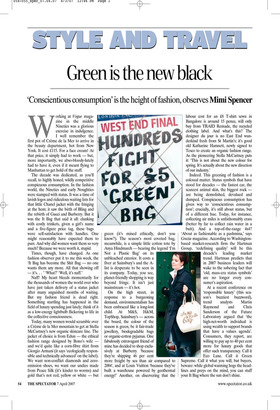Green is the new black
‘Conscientious consumption’ is the height of fashion, observes Mimi Spencer Working at Vogue magazine in the middle Nineties was a glorious exercise in indulgence. I well remember the first pot of Crème de la Mer to arrive in the beauty department, hot from New York. It cost £115. For a face cream! At that price, it simply had to work — but, more importantly, we abso-bloody-lutely had to have it, even if it meant flying to Manhattan to get hold of the stuff.
The decade was dedicated, as you’ll recall, to highly honed, wildly competitive conspicuous consumption. In the fashion world, the Nineties and early Noughties were stamped with status. It was a time of lavish logos and ridiculous waiting lists for that little Chanel jacket with the fringing at the hem; it saw the birth of Bling and the rebirth of Gucci and Burberry. But it was the It Bag that said it all: clanking with costly trinkets, given a girl’s name and a five-figure price tag, these bags were self-satisfaction with handles. One might reasonably have expected them to purr. And why did women want them so very much? Because we were worth it, stupid.
Times, though, have changed. As one fashion observer put it to me this week, the ‘It Bag has become the Shit Bag — no one wants them any more. All that showing off — it’s... ’ ‘What?’ ‘Well, it’s naff.’ Naff! My heart bleeds momentarily for the thousands of women the world over who have just taken delivery of a status jacket after many anguished months of waiting. But my fashion friend is dead right. Something startling has happened in the field of luxury spending just lately; think of it as a low-energy lightbulb flickering to life in the collective consciousness.
Today, many women would scramble over a Crème de la Mer mountain to get at Stella McCartney’s new organic skincare line. The jacket of choice is from Edun — the ethical fashion range designed by Bono’s wife and we’d quite like a corn-fibre shirt from Giorgio Armani (it says ‘ecologically responsible and technically advanced’ on the label). We want non-conflict diamonds and zeroemission shoes, we want our undies made from Peace Silk (it’s kinder to worms) and gold that’s not red, yellow or white — but green (it’s mined ethically, don’t you know?). The season’s most coveted bag, meanwhile, is a simple little cotton tote by Anya Hindmarch — bearing the legend ‘I’m Not a Plastic Bag’ on its unbleached exterior. It costs a fiver at Sainsbury’s and the Alist is desperate to be seen in its company. Today, you see, planet-friendly shopping is way beyond fringe. It isn’t just mainstream — it’s hot.
On the high street, in response to a burgeoning demand, environmentalism has been embraced like a long-lost child. At M&S, H&M, TopShop, Sainsbury’s — across the board, the colour of the season is green, be it fair-trade jewellery, biodegradable bags or organic-cotton pyjamas. One fabulously extravagant friend of mine has decided to shop exclusively at Burberry ‘because they’re shipping 46 per cent more freight by sea than air compared to 2004’, and at Louis Vuitton ‘because they’ve built a warehouse powered by geothermal energy!’ Another, on discovering that the labour cost for an £8 T-shirt sewn in Bangalore is around 15 pence, will only buy from TRAID Remade, the recycled clothing label. And what’s this? The designer du jour is no East End wunderkind fresh from St Martin’s; it’s good old Katharine Hamnett, newly signed to Tesco to create an organic fashion range. As the pioneering Stella McCartney puts it: ‘This is not about the new colour for spring. It’s actually about the new direction of our industry.’ Indeed. This greening of fashion is a colossal matter. Status symbols that have stood for decades — the fastest car, the scarcest animal skin, the biggest rock are being demolished, devalued and dumped. Conspicuous consumption has given way to ‘conscientious consumption’; crucially, it’s still about status, but of a different hue. Today, for instance, collecting air miles is unfathomably crass (better by far to collect rain water in a butt). And a top-of-the-range 4x4? ‘About as fashionable as a pashmina,’ says Grazia magazine. According to Washingtonbased market-research firm the Hartman Group, ‘redefining quality’ will be this decade’s leading market trend. Hartman predicts that in 2007 business leaders will wake to the sobering fact that ‘old, mass-era status symbols’ are no longer every consumer’s aspiration.
At a recent conference on ‘responsible luxury’ (this season’s buzziest buzzword), trend analysts Martin Raymond and Chris Sanderson of the Future Laboratory argued that ‘the high-net-worth individual is using wealth to support brands that have a values agenda’. Consumers, they report, are willing to pay up to 40 per cent more for luxury goods that offer such transparency. Call it Eco Luxe. Call it Green Supreme. Call it what you will, but buyers, beware: while global warming hogs the headlines and preys on the mind, you can stuff your It Bag where the sun don’t shine.


































































 Previous page
Previous page